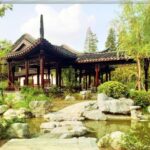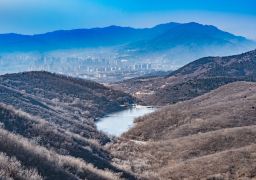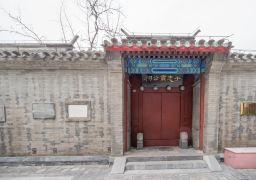Wulei Temple is located at the southern foot of Xiangwang Peak on Wulei Mountain in Guanhaiwei Town, Cixi City. According to relevant historical records such as the Guangxu Edition of ‘Cixi County Annals’, the rudiment of Wulei Temple emerged in the 3rd century. There are many scenic spots and historical sites in Wulei Temple. In front of the temple, there is a pool named ‘Zhenming Pool’. The clear water flows out gurgling from the Elephant Eye Tomb in the east and flows into Zhenming Pool. Then it flows to the Moon Lake through a small canal and never dries up all year round. It is said that this was also dug day and night by Narayana and his disciples. During this period, there were battles with demons in the mountain and many people were killed or injured. Therefore, it is also called ‘Wanggong Pool’. The water in the pool is clear, sweet and refreshing. Beside the pool, there are five Chinese red pines, which are used as incense wood of Wulei Temple and planted by later generations. On the hillside not far from the temple, there are several towering ancient trees. The age of some trees is difficult to estimate and several people are needed to encircle them. There are mostly camphor trees in the temple. With luxuriant branches and leaves, they are evergreen all year round and set off the golden buildings of Wulei Temple. In the first year of Wende (888 AD) of Emperor Xizong of the Tang Dynasty, the scale of Wulei Temple was greatly expanded. There are countless stupa pavilions and beautiful temples and pavilions, full of wonderful atmosphere. It can be truly said that ‘the ancient temple towers are high for avoiding summer heat, and the pines and cypresses on sunny days are cold in daytime’. According to legend, 2000 years ago, Narayana, an eminent Indian monk, visited famous mountains and scenic spots in China. After traveling over mountains and waters, he selected this land on Wulei Mountain. He built a thatched cottage on Wulei Mountain to preach scriptures and lit a bonfire to attract believers. When the raging fire rose to the sky, it was also the beginning day of cultural exchanges between China and India. However, although the holy fire was burning brightly, there were few responders. Separated by high mountains, it was difficult to find bosom friends. It is said that one day Sun Quan’s mother passed by on a boat and saw the faint bonfire. So she ordered people to investigate in detail and then knew the whole story. So she specially built a small temple at the place where the holy fire rose. This is probably the predecessor of Wulei Temple. With this small temple, Narayana ended his life of sleeping in the open and rinsing his mouth with stones for many years.
The specific opening hours and business status are subject to the opening situation on that day.Wulei Temple
Wulei Temple is located at the southern foot of Xiangwang Peak on Wulei Mountain in Guanhaiwei Town,[...]









